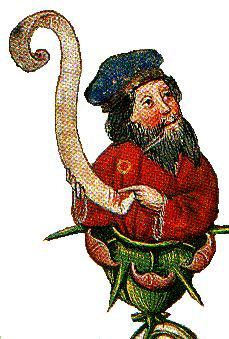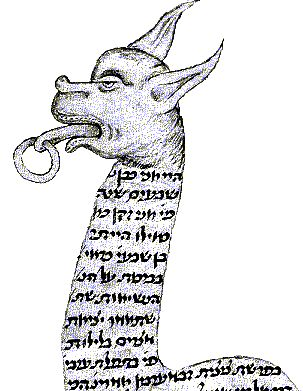
 A few years ago some computer enthusiasts in Israel claimed to have found coded words embedded in the text of the Hebrew Bible. These were found by searching the text, looking for letters spaced at equal intervals, which spelled out words. The three people who worked on this were Doron Witztum, Eliyahu Rips, and Yoav Rosenberg, They produced a paper Equidistant Letter Sequences in the Book of Genesis, which was eventually published in 1994 in an American statistical journal called Statistical Science. In this paper they said that they had not only found these words, but that these words were placed close to other related words.
A few years ago some computer enthusiasts in Israel claimed to have found coded words embedded in the text of the Hebrew Bible. These were found by searching the text, looking for letters spaced at equal intervals, which spelled out words. The three people who worked on this were Doron Witztum, Eliyahu Rips, and Yoav Rosenberg, They produced a paper Equidistant Letter Sequences in the Book of Genesis, which was eventually published in 1994 in an American statistical journal called Statistical Science. In this paper they said that they had not only found these words, but that these words were placed close to other related words.
When publishing this paper the journal said:
Our referees were baffled: their prior beliefs made them think the book of Genesis could not possibly contain meaningful references to modern-day individuals, yet when the authors carried out additional analyses and checks the effect persisted.
Those who wanted to believe in such codes, took this to mean that American statisticians had no explanation for these correlations. Because of these claims about codes, there are a number of people who believe that they had been deliberately placed there by God, waiting for humans with computers to discover and read them. Some have even suggested that it also shows that the text of the Hebrew Bible is literally perfect and exactly as given to Moses, for an alteration of just one letter would throw these sequences out and make them unreadable.
Others have made money as a result of the interest aroused by this paper. Michael Drosnin, has written a book entitled (The Bible Code), showing that recent events in history were mentioned in the Bible. His examples of events foretold include the assassination of Rabin and Iraq firing Scud missiles targeted at Israel. Software manufacturers too, have sold a lot of programs to DIY Code hunters.
MISLEADING DIAGRAMS.
The original article only gave a few illustrations of what they had found, but what they did show were rather misleading. If we look at fig. 2 in their paper we find this example of what the authors call "close proximity":

You will see that it shows the words Zedekiah (vertical) and Mattaniah (horizontal) are shown as almost converging. This is thought to be significant because they are both names for the same king.(see 2 Kings ch.24, v.17) In the illustration the two names appear equally spaced and very close together. But if one looks closely, one sees that the Hebrew text does not follow on from line to line. There is a considerable gap. The letters of Mattaniah are just two apart, while the letters of Zedekiah are about 7850 letters apart. The last letter of Zedekiah is 24 chapters away from Mattaniah. The letters of Mattaniah are in Genesis ch. 19, v.35 and the last letter of Zedekiah is in ch. 43, v.32. The two names which appear in the diagram to almost cross are in reality about 3,915 letters apart at their nearest point, which is a distance of about 3 whole chapters.
It is also significant that although the name Zedekiah appears to be written downwards, the name of Mattaniah is written backwards. Surely if an all-knowing and all-wise Deity chose to write a code in His revealed teachings, He would have produced a more perfect one than this.
CHANCES OF FINDING "CODE" WORDS.
If they found a word at intervals of 7850, presumably they must have searched even wider. Let us suppose they used a round figure of 10,000 letters apart as their limit. What then is the likelihood of finding words in the Torah under these circumstances? As Mattaniah is spelled backwards the text is apparently doubly searched, ie. backwards and forwards. The total number of letters in the Hebrew text of the Torah, which they used, is 304,805. (To be fair, the authors of the paper used only the Book of Genesis, so the following calculations only apply to those people who search all the five books.) When searching for a four lettered word the computer would examine over two and a half billion (2,648,090,000) combinations of letters, you are likely, on average, to find 11,304 occurrences of any one word. (and more if it was composed of the more commonly used letters).
On average you are likely find:

One should bear in mind that as Hebrew does not have vowels, and Hebrew words are shorter than the equivalent English ones. All this explains why many of Doron's examples are based upon short words. The chances of getting two related words to overlap can be greatly increased because it is possible to think of a number of suitable words. Take a word like Chanukah for example, it is not difficult to think of words like: oil, lights, Menorah, Judah, Mattathias, Maccabee, Hasmonean, Temple, Sacrifices, Maoz Tsur, Dreidel, altar, Latkes, Modin and Miracles, and each would have provided a suitable link. And with a little effort one can think of many more. If you looked for these 15 words, you would of course be 15 times more likely to find a match.
The above explanations do not fully deal with the arguments of the original article by Witztum, Rips, and Rosenberg, which described finding a list of Rabbis names and birthdays and dates of death. If you wish to follow the arguments in greater detail you can find these in papers The Case Against the Codes by Professor Barry Simon (http://wopr.com/biblecodes/TheCase.htm) where he refers to "wiggle room" in this experiment concerning Rabbis, and in Torah Codes: Reality or Illusion by M. Hasofer, Emeritus Professor of Statistics, University of New South Wales (http://cs.anu.edu.au/~bdm/dilugim/hasofer.html), both of whom are academic statisticians.
The man who published the original paper in Statistical Science and who said: "Our referees were baffled" has issued the following clarification:
STATEMENT OF ROBERT E. KASS.
Some people seem to think that the publication of the Witzum, Rips, and Rosenberg article in Statistical Science served as a stamp of scientific approval on the work. This is a great exaggeration. Statistical Science publishes a wide variety of papers of general interest to statisticians. Although the referees thought carefully about possible sources of error in the work, no one tried to reanalyze the data carefully and independently to try to uncover the presumed flaw in the logic.These views are backed by 48 other Academics who hold a PhD in either Maths or Statistics or else are faculty members of a Maths or Statistical department of a College or University they have signed a statement which includes the following passage:
The very few public statements I have made seem to have been misinterpreted to lend support to the notion that there may be some scientific basis for the findings of Witzum, Rips, and Rosenberg. My personal belief is quite the opposite: the authors' work did not go far enough to make me seriously think, even for a moment, that their results were anything other than coincidental, and likely due to a subtle flaw in their methodology. As I said in the preface to that issue of the journal, the paper was offered to our readers as a challenging puzzle. We published it in the hope that someone would step forward and do the careful analysis required to solve the puzzle, and that the discipline of statistics would be advanced through the identification of the logical errors in this kind of pattern recognition.
The source for this is on http://lib.stat.cmu.edu/~kass/biblecodes
We are making this statement concerning what have been called "Bible codes" or "Torah codes". We recognize that many sincere people take this phenomenon seriously, which compels us to speak out on the basis of what our mathematical training tells us about the evidence claimed for this alleged phenomenon.
There is a common belief in the general community to the effect that many mathematicians, statisticians, and other scientists consider the claims to be credible. This belief is incorrect. On the contrary, the almost unanimous opinion of those in the scientific world who have studied the question is that the theory is without foundation. The signatories to this letter have themselves examined the evidence and found it entirely unconvincing.

For the full text and list of signatories see http://math.caltech.edu/code/petition.html
CONCLUSIONS.